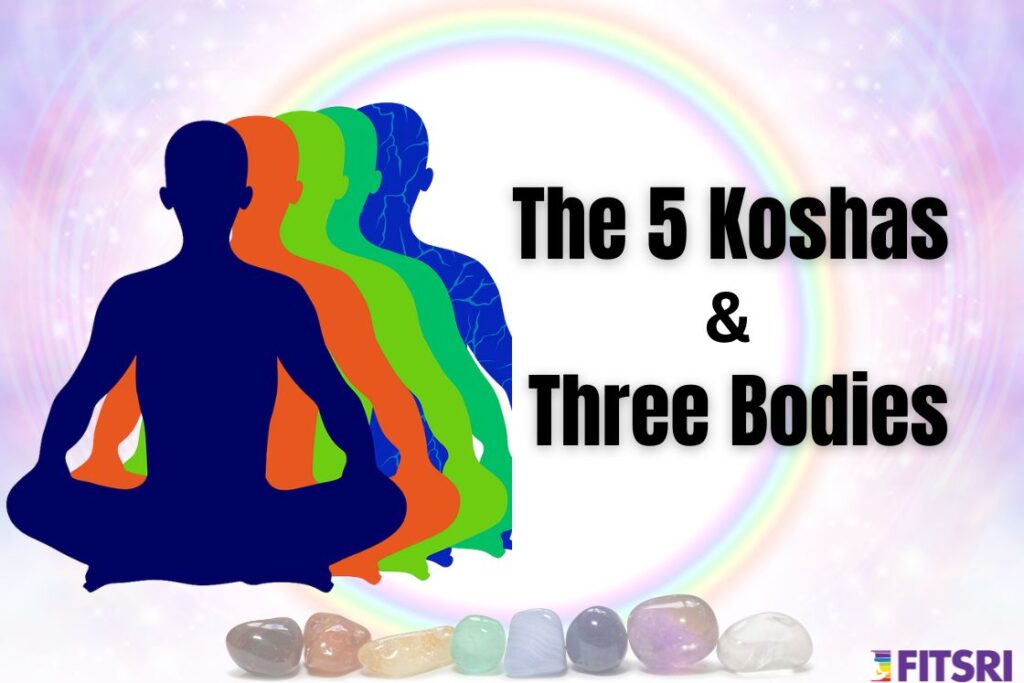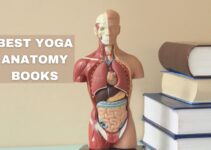
Have you ever wondered what the subtle body truly is, and how it differs from the causal body?
Every layer of the body whether subtle or gross is a manifestation of energy. And energy is not seen, but felt, through the flow of consciousness.
In yogic philosophy, consciousness flows through five layers to reach the innermost essence, known as the Atman (or Self, in Vedanta). These five layers are called the koshas.
To truly understand the koshas, one must first grasp the concept of the Self the innermost being that remains after transcending all five sheaths. Let’s begin there.
Introduction to self or atman
The Self, or Atman, is the divine essence within every being. It exists beyond the three gunas Sattva, Rajas, and Tamas as it has neither beginning nor end. Its core qualities are constant awareness and silent support to all, without any attachment.
In the Upanishads, the Atman is described as the unchanging witness that remains present through all states of existence waking, dreaming, deep sleep, death, rebirth, and ultimate liberation.
References from upanishads about atman
Several Upanishads describe the nature of Atman through powerful verses.
- The Kathopanishad defines Atman as subtler than the subtlest and greater than the greatest, residing in the heart of every living being.
Anoraniyan mahato mahiyan Atmasya jantornihito guhayam (Katho.I-ii-20).
This verse highlights Atman as the eternal presence within the body.
- The Mandukya Upanishad states that Brahman is the Atman, and Atman is the Brahman.
Ayam Atma Brahma (Mandukya )
This expression reveals that the supreme power behind all existence is one with the innermost Self in each heart.
- The Brihadaranyaka Upanishad identifies the Self with Purusha, the infinite and all-pervading being. It clarifies that the Self is distinct from the intellect and separate from the sensory organs.
- The Mundaka Upanishad describes the Self as self-luminous, formless, without origin, and pure. It is the all-pervading presence, both within and without. This Being exists before life and thought, and even transcends the unmanifested causal state of the universe.
Nature of atman
The Atman is described in Vedantic texts through several key qualities:
- Chaitanya Svarupah – The very nature of pure consciousness
- Svatantrah – Completely independent, not dependent on anything
- Nirgunah – Beyond material qualities, without any attributes
- Nityah – Eternal and unchanging
- Sarvagatah – Present everywhere, all-pervading
- Ekah – One without a second, the indivisible Self
These qualities point to the absolute nature of Atman, which remains untouched by time, space, or change.
Relation between koshas and atman
Kosha means “sheath” the layers that cover the Atman. The Atman, or soul, resides at the core of the Anandamaya Kosha (the fifth sheath), which is described later in this article.
The Atman is distinct from the five koshas. Just as smoke, which arises from fire, can conceal the fire, the koshas though dependent on the Atman for their existence veil the presence of the Atman. Yet, it is the Atman that illuminates and pervades them all.
In Ayurvedic and philosophical texts, two types of relationships are described:
- Samavaya relation – An inseparable relationship
- Samyoga relation – A temporary or separable connection
Samavaya is discussed in Padarth Vigyan (the science of matter) as the inseparable bond between a subject and its inherent qualities. However, there is no Samavaya relationship between the Atman and the koshas.
Samyoga describes a separable relationship, like that between a drum and a stick. But even this cannot apply to the Atman and the koshas, because the Atman is not composed of the five elements or physical matter.
The relationship between Atman and the koshas is only the Adhyasa (illusory or superimposed).
Human personality & concept of koshas
Guhāhitaṁ Brahma yat tat pañcakośa vivekataḥ, boddhuṁ śakyaṁ tataḥ kośa pañcakaṁ pravi vicyate
This verse refers to Brahman hidden in the cave of the heart, which is to be understood through the discrimination of the five koshas.
The human personality is a blend of physical, mental, and spiritual aspects. It includes patterns of thoughts, emotions, behaviours, social interactions, values, and attitudes that shape one’s self-perception and life experience.
According to the Upanishads, the Purusha (the Self or inner being) exists in terms of:
- Three bodies (Sharira-traya) – gross, subtle, and causal
- Five sheaths (Pancha Koshas) – layers that cover the Self
These layers help explain how the Self expresses through different levels of human existence, from the physical to the blissful.
Historical background
- The Taittiriya Upanishad describes the human being as having a five-sheath personality (Pancha Kosha), which corresponds with the concept of Sharira Traya the three bodies.
- The Triguna Theory: Ancient Indian philosophy explains that personality can be refined through tapas (austerity) and value-based education, guided by the concept of the three gunas—Sattva, Rajas, and Tamas. These gunas bind the soul to the material world and influence mental and emotional tendencies..
- Principles from Sankhya Philosophy: According to Sankhya philosophy, there are two eternal principles:
- Purusha – Conscious, intelligent, and inactive
- Prakriti – Unconscious, non-intelligent, and active
These two are interconnected and together give rise to the formation of the Sharira Traya (three bodies), which will be explained further in this article.
- In Ayurvedic texts, personality is also classified into 16 types based on the gunas 7 Sattva, 6 Rajas, and 3 Tamas types. These classifications describe dominant traits and temperaments in individuals.
The theory of Pancha Koshas, as mentioned in the Taittiriya Upanishad, offers a Vedantic psycho-philosophical framework to understand human personality across physical, mental, and spiritual dimensions.
Pancha-kosha: 5 Layers to the self

In Sanskrit, Kosha means “sheath” or “covering.” Koshas are understood as layers through which awareness flows—from the outer body toward the inner Self and thus cover the Atman.
Pancha Kosha refers to the concept in yogic philosophy that there are five layers or sheaths surrounding the human soul. These layers also represent the five aspects of human personality.
Much like the chakra system, the five koshas are arranged one within the other—from the outermost physical layer to the innermost sheath of bliss. These five layers exist across the three bodies (Sharira Traya) known as the gross, subtle, and causal bodies.
The ancient view of “personality” or “body constitution” is structured through these five sheaths:
- Annamaya Kosha
- Pranamaya Kosha
- Manomaya Kosha
- Vijananamaya Kosha
- Anandamaya Kosha
1. Annamaya Kosha(physical sheath)
Annamaya comes from Anna (food) and Maya (made of). This sheath represents the physical body, which is nourished by food and composed of the five elements earth, water, fire, air, and space. It is associated with the Root Chakra and the earth element.
This sheath is dominated by Tamo Guna, and it is perishable, having both a beginning and an end.
In yoga, physical postures (asanas) help strengthen and balance the Annamaya Kosha.
This sheath arises from the union of Shukla (male seed) and Sonita (female seed), and continues its development through nourishment from food. Even semen, as per Ayurvedic understanding, is a by-product of food synthesis.
The Annamaya Kosha forms the base of personality, influencing one’s physical, emotional, and social traits, and it undergoes the six modifications (Shad Bhava Vikara):
- Birth
- Existence
- Growth
- Change
- Decay
- Death
Methods to purify and develop this sheath include:
- Upavas (fasting)
- Asanas (Yogic postures)
- Tatvashudhi (Inner Purification)
- Tapashcharya (Practice of austerity).
- Letting our soul free from worldly attachments from the physical body are the first objective of spirituality. (3)
The first step in spirituality is to detach the soul from the identification with this food sheath. Most modern medicine primarily acts on this layer.
2. Pranamaya kosha (vital energy sheath)
Pranamaya refers to the sheath made of prana, the life force. It includes the five major pranas, which sustain the physical body and serve as a bridge to the mental layer (Manomaya Kosha).
This kosha is influenced by Rajo Guna, indicating dynamic activity. Though more subtle than the physical body, it too is perishable and has a beginning and an end.
In yoga, pranayama (breathing techniques) and asanas regulate this sheath. Prana originates from Moola Prakriti the Divine Mother or root of nature.
3. Manomaya Kosha (mental sheath)
The Manomaya Kosha is made up of the mind and is nourished by thoughts and sensory impressions. It plays a vital role in processing emotions, desires, and interactions with the world.
This sheath includes the gyanendriyas (sense organs) and karmendriyas (organs of action), which help us perceive and act upon the outer world:
- Gyanendriyas are the five sense organs; eyes (vision), ears (hearing), nose (smell), tongue (taste), and skin (touch)—through which we perceive objects.
- Karmendriyas are the organs of action that allow us to respond to the environment, such as hands, feet, mouth (speech), reproductive organs, and organs of excretion.
The Manomaya Kosha is formed by a combination of Sattva guna (purity) and Tamo guna (inertia). It is perishable in nature—meaning it has a beginning and an end.
This kosha acts as the mental faculty that receives sensory signals, interprets them as positive or negative, and then develops desires—mainly aspiring for what is perceived as positive.
The primary functions of the Manomaya Kosha include:
- Sankalpas – interpreting intentions and preparing the mind to act accordingly.
- Vikalpas – rejecting negative or undesirable thoughts and actions.
The mind holds certain traits known as Vrittis like lust, anger, greed, and more. These Vrittis cause the thoughts in the mind to constantly fluctuate, which is why the mind is called Vikari (subject to change).
In contrast, the Atman our true Self is Nirvikara, meaning it is unchanging and beyond all modifications.
The mind, along with the five sense organs (tongue, nose, eyes, ears, and skin), forms the Manomaya Kosha, also called the mind-sheath.
Various aspects of yoga practice influence this kosha. For example:
- Meditation calms the restless mind.
- Alternate nostril breathing (Nadi Shodhana) balances mental energy and improves clarity.
4. Vijnanamaya Kosha (wisdom sheath)
The Vijnanamaya Kosha, or intellectual sheath, is made up of vijnana, which means intellect or wisdom. This kosha is closely linked to the throat chakra and governed by the air element, representing clarity, expression, and understanding.
It comprises the intellect (buddhi) along with the five sense organs, and governs deeper mental functions such as willpower, discrimination, and decision-making. It is nourished by the ego and shapes our ability to analyse, judge, and respond consciously to life experiences.
This sheath functions even in the deep sleep state, where pure intelligence reflects as Chidabhasa the subtle reflection of consciousness in the intellect.
Although subtle, the Vijnanamaya Kosha depends on the more external sheaths (like the body and breath) for its functioning. In yogic philosophy, meditation is the key practice to purify and transcend this sheath, allowing one to move closer to the inner self.
5. Anandamaya kosha (bliss sheath)
Ananda means a state of deep joy or bliss. In Advaita Vedanta, the Anandamaya Kosha is the innermost sheath and is closest to the soul (Atman). Because of this close connection, it naturally reflects the joy that comes from the soul.
This sheath is connected to emotions and consciousness. It belongs to the causal body and is often seen as the layer where the soul expresses itself. The Anandamaya Kosha is not limited by thoughts or actions. It is felt most clearly during deep sleep, where the mind is quiet and the person experiences peace without knowing it.
This kosha expresses three beautiful qualities of the soul:
- Sat – Truth and eternal being
- Chit – Consciousness or awareness, the quality that shows something is alive
- Ananda – Pure joy or happiness
The Anandamaya Kosha is the most subtle of all five koshas. It can only be felt when the mind is calm and the other sheaths are balanced. Bliss comes not from outside but from the deep connection with our inner self.
5 Koshas lies in three bodies (sharira traya)
The five koshas (sheaths) that shape human personality are not separate from our body but exist within three levels of our being, called the Sharira Traya the Gross Body, Subtle Body, and Causal Body. Each kosha finds its place within these three bodies and reflects a specific layer of our existence.
1. Sthula Sharira/ Gross Body
- The gross body is the physical body underlined with the sheath of Prana – the vital air.
- It’s the product of 5 Gross Elements (Earth, Water, Fire, Air, Space).
- This body is Subject to 6 changes (Existence, Birth, Growth, Change, Decay & Death).
- Physical medium to experience pain & pleasure.
- Contains the body in Seed form in Waking State (Jagrata Avastha) viz Mind is fully Functional (purna vikasah).
2. Linga Sharira/ Subtle or Astral Body
- The subtle body is the vital energy field for balancing mental and intellectual state.
- It contains Pranamaya Kosha (sheath of prana), the Manomaya Kosha (sheath of mind), and the Vigyanmaya Kosha (sheath of intellect).
- Product of 5 Subtle Elements
- 5 Organs of Perception (jnanendreiya) & 5 Organs of Action (karmandreiya)
- 5 Vital Forces (prana)
- Contains the Body in Seed form in Dream State (Svapna Avastha) in which mind is partially Functional (Ardha vikasah).
3. Karan Sharira/ Casual Body
Karana Sharira or Causal body is the map template which is the sole cause for the gross and subtle bodies.
- The causal body manifests the ego.
- Anandmaya Kosh (sheath of bliss) resides in the Causal body (Karana Sharira).
- It defines the state of Ignorance (avidya), Indescribable, Beginningless
- Contains the Body in Seed form in Dream-less Deep Sleep (sushupti – Nitya pralaya) i.e. Mind is almost Non-Functional (avikasah).
- Karta and bhokta viz the doer and the enjoyer, designate the intellectual sheath and the causal sheath.
- In the causal sheath, there is a balancing of the properties of Nature (Prakriti)—sattva, rajas, and tamas
Conclusion
Hindu scriptures describe the body–mind complex as made up of five sheaths (koshas):
- Annamaya kosha: the physical sheath
- Pranamaya kosha: the sheath of prana (the vital air)
- Manomaya kosha: the sheath of mind
- Vijnanamaya kosha: the sheath of intellect
- Annadmaya kosha: the sheath of bliss.
These sheaths are layered one within the other, with the Annamaya Kosha (physical body) as the outermost and the Anandamaya Kosha (bliss sheath) as the innermost. The journey of spiritual growth begins by detaching from the outermost sheath and moving inward.
The first step in spiritual practice is freeing the soul from attachment to the physical body. The ultimate aim is to move beyond the physical and mental levels and abide in the Vijnanamaya (wisdom) and Anandamaya (bliss) sheaths, where the experience of true self and inner peace resides.





May I request you to enlighten me more on 16 types of personality (7 sattva, 6 rajas and 3 tamas) and references?
This has been requested before and your team may have answered by email. Please send it to my email. Thanks.
Hello! Love your article. How do I contact you for some of my health issues consult?
Beautiful article… Madam, have you written any book on Yoga?
Thank you so much for sharing the vital spiritual information ???
Great article! May I print and share this with a few students? You will be accredited appropriately, of course. Thank you!
Yeah sure, you can use it for print.
Has the article on 16 types of personality been prepared? If so, may I have a copy of the document/description on my email, please?
Thank you for showing interest in our content. The article on 16 types of personality is not prepared yet. We will notify you via email once we prepare it.
More thought provoking. Thank you.
May I request you to enlighten more on 16 types of personality (7 sattwas, 6 rajas and 3 tamos) and references.
Sure, we will prepare an article on 16 types of personality very soon in the near future. As soon as we do this, we will let you know via email.
If I seek an answer From my subconscious mind, from where can I get that answer, from monomoy kosha or from vigganmoy kosha? Actually in which body does the subconscious exist ? Please give me a reply to the following email address. [email protected]
That is a great and deep question with various perspectives to answer it.
Actually, We cannot just identify one kosha with one feature, all are interconnected and works in a hierarchical manner as each kosha is more refined than the next but influencing those below it.
You will get a detailed explanation of it on mail from fitsri team.
If someone has never done fasting How can one really start it to purify Annamaya kosha please guide
Fasting can zap us into an intimate conversation with our relationship to food and what is necessary to consume as fasting has immense power to get rid of body toxins and mental impurities.
Fasting involves a new regimen of eating as per the dietary rules, you can start up with fasting once in a week but let fasting be a detoxification therapy rather than torture.
You can work on purification of Annamaya kosha with this:
1. Drink one to four quarts of water per day.
2. Start with a mono-diet is also a good option as eating only kitchari for only one day and with a healthy diet schedule the next day can be continued.
3. A short term fast viz giving time to your digestive system to rest and repair & heal.
4. Have a fewer and a light meal the night prior to the day of fasting.
awesome and unique article!